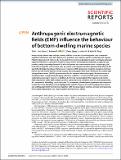Files in this item
Anthropogenic electromagnetic fields (EMF) influence the behaviour of bottom-dwelling marine species
Item metadata
| dc.contributor.author | Hutchison, Zoë L. | |
| dc.contributor.author | Gill, Andrew B. | |
| dc.contributor.author | Sigray, Peter | |
| dc.contributor.author | He, Haibo | |
| dc.contributor.author | King, John W. | |
| dc.date.accessioned | 2020-12-07T15:59:27Z | |
| dc.date.available | 2020-12-07T15:59:27Z | |
| dc.date.issued | 2020-03-06 | |
| dc.identifier | 271538393 | |
| dc.identifier | 82ee0827-7767-4897-be97-55afa0566eb3 | |
| dc.identifier | 85081289198 | |
| dc.identifier | 32144341 | |
| dc.identifier.citation | Hutchison , Z L , Gill , A B , Sigray , P , He , H & King , J W 2020 , ' Anthropogenic electromagnetic fields (EMF) influence the behaviour of bottom-dwelling marine species ' , Scientific Reports , vol. 10 , 4219 . https://doi.org/10.1038/s41598-020-60793-x | en |
| dc.identifier.issn | 2045-2322 | |
| dc.identifier.other | ORCID: /0000-0003-1866-7877/work/87404774 | |
| dc.identifier.uri | https://hdl.handle.net/10023/21117 | |
| dc.description | Funding: Bureau of Ocean Energy Management (contract number M14PC00009), representing an integrated analysis drawn from the work fully reported in OCS Study Report Number BOEM 2018-003. | en |
| dc.description.abstract | Many marine animals have evolved sensory abilities to use electric and magnetic cues in essential aspects of life history, such as to detect prey, predators and mates as well as to orientate and migrate. Potential disruption of vital cues by human activities must be understood in order to mitigate potential negative influences. Cable deployments in coastal waters are increasing worldwide, in capacity and number, owing to growing demands for electrical power and telecommunications. Increasingly, the local electromagnetic environment used by electro- and magneto-sensitive species will be altered. We quantified biologically relevant behavioural responses of the presumed, magneto-receptive American lobster and the electro-sensitive Little skate to electromagnetic field (EMF) emissions of a subsea high voltage direct current (HVDC) transmission cable for domestic electricity supply. We demonstrate a striking increase in exploratory/foraging behaviour in skates in response to EMF and a more subtle exploratory response in lobsters. In addition, by directly measuring both the magnetic and electric field components of the EMF emitted by HVDC cables we found that there were DC and unexpectedly AC components. Modelling, restricted to the DC component, showed good agreement with measured results. Our cross-disciplinary study highlights the need to integrate an understanding of the natural and anthropogenic EMF environment together with the responses of sensitive animals when planning future cable deployments and predicting their environmental effects. | |
| dc.format.extent | 15 | |
| dc.format.extent | 1770886 | |
| dc.language.iso | eng | |
| dc.relation.ispartof | Scientific Reports | en |
| dc.subject | GC Oceanography | en |
| dc.subject | QH301 Biology | en |
| dc.subject | E-DAS | en |
| dc.subject | SDG 14 - Life Below Water | en |
| dc.subject.lcc | GC | en |
| dc.subject.lcc | QH301 | en |
| dc.title | Anthropogenic electromagnetic fields (EMF) influence the behaviour of bottom-dwelling marine species | en |
| dc.type | Journal article | en |
| dc.contributor.institution | University of St Andrews. School of Biology | en |
| dc.identifier.doi | https://doi.org/10.1038/s41598-020-60793-x | |
| dc.description.status | Peer reviewed | en |
This item appears in the following Collection(s)
Items in the St Andrews Research Repository are protected by copyright, with all rights reserved, unless otherwise indicated.

